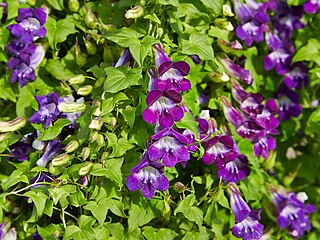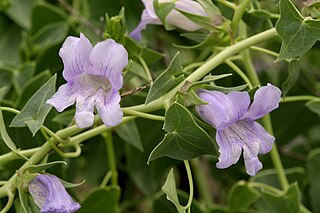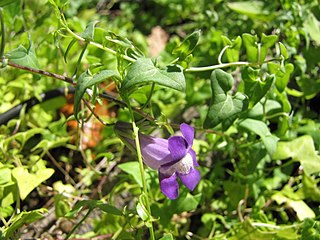
Sphagneticola trilobata, commonly known as the Bay Biscayne creeping-oxeye, Singapore daisy, creeping-oxeye, trailing daisy, and wedelia, is a plant in the tribe Heliantheae tribe of the family Asteraceae. It is native to Mexico, Central America, and the Caribbean, but now grows throughout the Neotropics. It is widely cultivated as an ornamental groundcover.

Thunbergia alata, commonly called black-eyed Susan vine, is a herbaceous perennial climbing plant species in the family Acanthaceae. It is native to Eastern Africa, and has been naturalized in other parts of the world.

Vinca major, with the common names bigleaf periwinkle, large periwinkle, greater periwinkle and blue periwinkle, is a species of flowering plant in the family Apocynaceae, native to the western Mediterranean. Growing to 25 cm (10 in) tall and spreading indefinitely, it is an evergreen perennial, frequently used in cultivation as groundcover.

Campanula latifolia, the giant bellflower, is a species of bellflower in the family Campanulaceae. It is also known as the large campanula and the wide-leaved bellflower. It is native to Europe and western Asia and is widely grown as an ornamental plant.

Rhodochiton is a genus of flowering plants within the family Plantaginaceae, native to southern Mexico and neighbouring Guatemala. They climb by means of twining leaf stalks. One of the three species, Rhodochiton atrosanguineus, the purple bell vine, is grown as an ornamental plant. All three species are sometimes included in Lophospermum.

Momordica balsamina is a tendril-bearing annual vine native to the tropical regions of Africa, introduced and invasive in Asia, Australia, Central America, and North America, where they have been found in some parts of Florida. In 1810, Thomas Jefferson planted this vine in his flower borders at Monticello along with larkspur, poppies, and nutmeg.

Lophospermum is a genus of herbaceous perennial climbers or scramblers, native to mountainous regions of Mexico and Guatemala. Those that climb use twining leaf stalks. Their flowers are tubular, in shades of red, violet and purple, the larger flowers being pollinated by hummingbirds. Now placed in the greatly expanded family Plantaginaceae, the genus was traditionally placed in the Scrophulariaceae. The close relationship with some other genera, particularly Maurandya and Rhodochiton, has led to confusion over the names of some species.

Maurandya barclayana, commonly called angels trumpet or Mexican viper, is an ornamental plant in the family Plantaginaceae native to Mexico.

Malva sylvestris is a species of the mallow genus Malva in the family of Malvaceae and is considered to be the type species for the genus. Known as common mallow to English-speaking Europeans, it acquired the common names of cheeses, high mallow and tall mallow as it migrated from its native home in Western Europe, North Africa and Asia through the English-speaking world.

Dalibarda repens(dewdrop, false violet, star violet, Robin runaway. French Canadian: dalibarde rampante) is a perennial plant in the rose family, native to eastern and central Canada and to the northeastern and north-central United States. It is the only species in the genus Dalibarda, which is closely allied with the genus Rubus. The species is often included in the genus Rubus as Rubus repens (L.) Kuntze. It is fairly easily grown in shady locations in damp to wet, acidic soils, and is frequently used in wildflower and bog gardens as a ground-cover.

Antirrhinum filipes is an annual species of North American snapdragon, usually known by the common name yellow twining snapdragon. This herbaceous plant is native to deserts of the southwestern United States and northern Mexico, where it is common.

Asarina is a flowering plant genus of only one species, Asarina procumbens Mill. the trailing snapdragon, which is native to France and Spain and introduced in Germany, Switzerland, Austria and Hungary. Originally placed in the Scrophulariaceae, the genus has more recently been moved to the Plantaginaceae. Species from North America formerly placed in the genus Asarina are now placed in Holmgrenanthe, Lophospermum, Mabrya and Maurandya, as well as Neogaerrhinum. Asarina is now regarded as exclusively an Old World genus.

Maurandya is a genus of flowering plants in the family Plantaginaceae, native to Mexico and the south west United States. They sprawl or climb by means of twining leaf stalks. One of the four species, Maurandya barclayana, is widely cultivated as an ornamental plant.

Holmgrenanthe petrophila is a rare perennial desert plant in the plantain family (Plantaginaceae), and the sole species of the genus Holmgrenanthe. It forms low mats of branched stems growing from a woody base. The leaves have small spines along their edges. The solitary yellow flowers are tubular with five free lobes at the end, the upper two pointing backwards, the lower three projecting forwards. The species is known only from about ten locations, most in the Titus Canyon and the adjacent Fall Canyon, all within the Californian section of Death Valley National Park. It grows in limestone crevices on the canyon walls, often on the north face.

Lophospermum erubescens, known as Mexican twist or creeping gloxinia, is a climbing or sprawling herbaceous perennial plant, native to the Sierra Madre Oriental mountains of Mexico, where it is found along forest margins or canyon walls. It climbs by means of twining leaf stalks. Wild plants have pink and white tubular flowers, although other colours are found in cultivation. It has been cultivated as an ornamental plant since at least 1830. Although not frost-hardy, it will survive if its base and roots are protected from freezing in the winter. It has escaped from cultivation and become naturalized in tropical and subtropical areas of the world.

Lophospermum scandens is a scambling or climbing herbaceous perennial native to south central Mexico, with red-violet and white tubular flowers and toothed heart-shaped leaves. It grows at elevations between 1,400 and 2,400 m in dry habitats, including deciduous oak forests and recent lava flows. The long-tubed flowers are pollinated by hummingbirds. It has been used in gardens as an ornamental plant since the mid-19th century. Its roots require protection from frost in regions where this occurs in the winter. Hybrids of L. scandens are also grown.

Mabrya is a genus of flowering plants in the plantain family, Plantaginaceae. It consists of herbaceous perennials with brittle upright or drooping stems, found in dry areas of Mexico and the southern United States.

Maurandya wislizeni is a scrambling or climbing herbaceous annual native to Mexico and the south western United States where it grows in sand dunes. It has tubular flowers in shades of blue to violet and white and more-or-less triangular untoothed leaves. It has been placed in a separate genus as Epixiphium wislizeni.

Maurandya antirrhiniflora, known as roving sailor or climbing snapdragon, is a scrambling or climbing herbaceous perennial native to Mexico and the south western United States where it grows in a variety of relatively dry habitats. It has sometimes been put into a separate genus as Maurandella antirrhiniflora.
Mabrya rosei is a mat-forming herbaceous perennial native to the Mexican states of Jalisco and Zacatecas. It has tubular flowers, whitish at the base and red to red-violet at the apex. It was first described by Philip A. Munz in 1926 in the genus Maurandya and transferred to Mabrya by Wayne J. Elisens in 1985. Munz did not explain the origin of the epithet rosei but listed the collector of the type specimen as Joseph Nelson Rose.



















